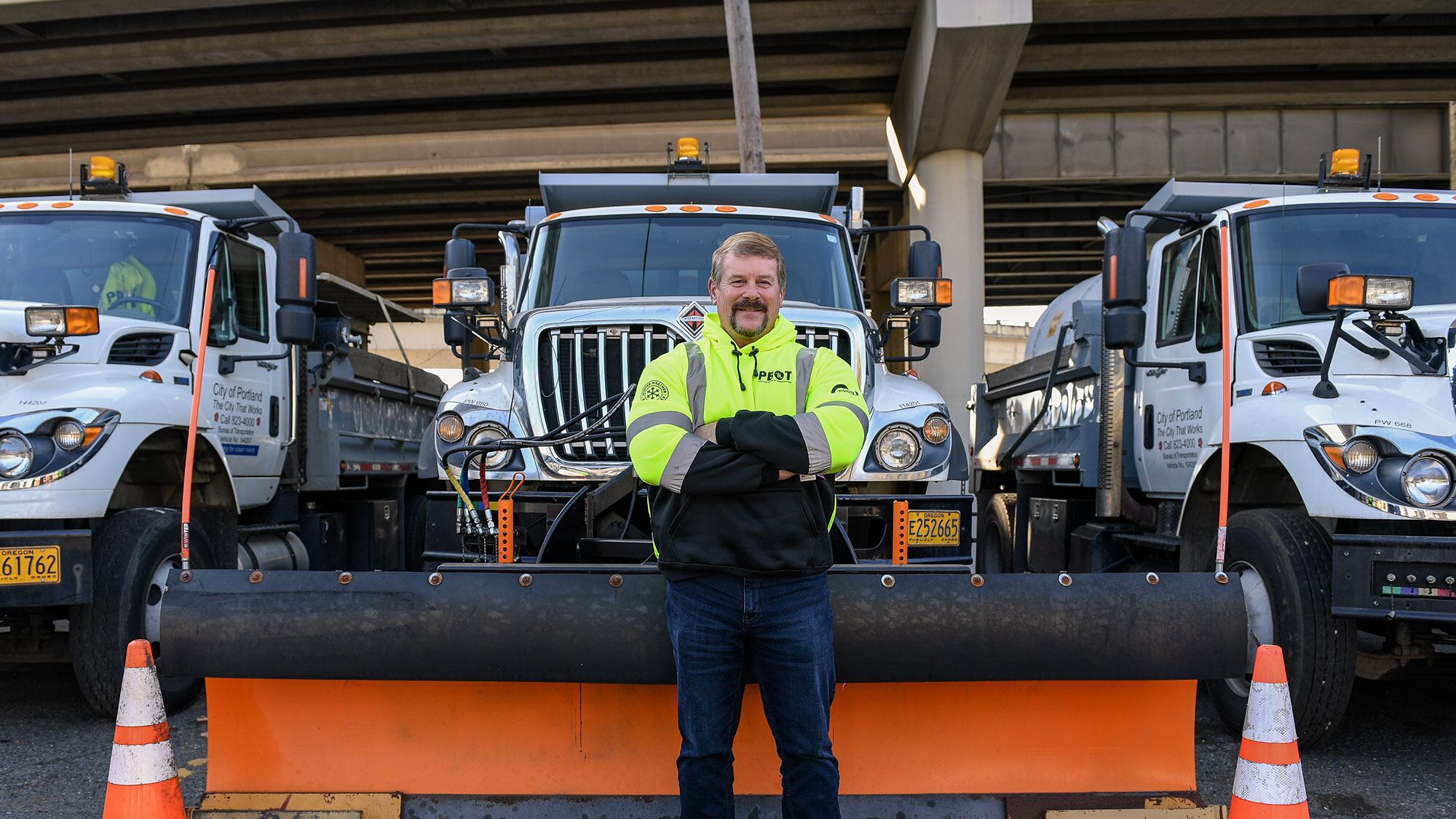Ted Harvey knows operating a snow plow in Portland seems a little absurd.
"People think we're crazy because we're out with snow plows in sunny, dry weather," he says. "They say, 'What are you guys doing? How are you spending our money?'"
But on those rare occasions when the snow does come down here, there might not be a more important job. Harvey would know: He spent 13 years behind the wheel of a plow, retiring from active duty in 2017 to serve as a mentor to younger drivers that come through the Portland Bureau of Transportation each hiring season. And as Harvey will tell you, operating a plow is no casual roll through winter wonderland.
"You can't relax in our seat when you're in downtown areas or in a real high-end or busy residential area," says Harvey, 60, a stocky man with calloused hands and a goatee. "You're on heightened alert because you are constantly splitting your peripheral, what people are doing, what's going on."
The bureau has 112 employees trained as plow drivers. If snow comes, it's on them to take up a shift of up to 12 hours in a vehicle so heavy that if a pedestrian gets in its way by accident, it's more prudent to try to crash into a parked car or a building than steer out of the way.
Since there's no guarantee snow will come to Portland on any given year, there is no one in Portland whose job is exclusively to move snow. Harvey works primarily as a concrete finisher, but he signed up as a plow driver in 2003 for overtime and found himself enjoying it more than he expected.
"I loved the plow," he says. "I loved the views at night. I loved the whole deal."

Each plow driver is designated a day or night shift and certain areas of town. Drivers focus on "primary streets"—busy thoroughfares served by buses and streetcars—before turning their attention to smaller, residential "secondary streets." PBOT surveys about 1,750 miles of Portland roadway in total.
Harvey's haunts were Northwest Portland, home to many high roads that become treacherous in winter, and what PBOT calls the CBD—the Central Business District, or downtown.
Downtown pedestrians are often snowed off the sidewalk and are forced to step into the street—the path of the plow. That's just one of the many dangers to which drivers are constantly on heightened alert: cars pulling out in front of the plow, tree limbs and wires covered in ice with the potential to fall, all on slippery streets with low visibility.
"It gets hard to see," says Harvey. "We have our lights flashing. They reflect off buildings, reflect off vehicles. We have the front flashers going, we have the back ones going, we're constantly looking around."
Then there are the victims of winter hazards drivers occasionally encounter—especially on Germantown Road, that tree-lined, serpentine street that winds up to Skyline Boulevard a thousand feet above sea level.
"There are so many vehicles that run off that road, I can't tell you how many," says Harvey. "Within an hour or two, you'll have four or five vehicles."

In one case, Harvey had to call the police to rescue a car that had veered off the side of the road.
"They landed against a tree that stopped them from going another 50 or 100 feet down to a creek below," he says. "We were already traveling on that lane, and we come back around again and we noticed this dirty snow and tracks, so we stopped and we looked down and they were over the edge. They weren't injured, but they were freezing."
Such hazards explain the intensive yearly training. PBOT maintains an obstacle course for plows at Sunderland Yard in Northeast Portland. The vehicles—which are trucks with modifications, not the romantic little machines we know from the "Mr. Plow" episode of The Simpsons—run it fully equipped.
Plow drivers relearn every October and November how to put on various chains and sanders and operate each of the three sizes of trucks used in plowing. If routes change or new roads are added in the city, they're considered in the obstacle course. The yearly event is as much about PR as training—PBOT encourages news crews to cover the course and even allows civilians to take the wheel from time to time, to encourage Portlanders to appreciate the difficulty of driving a plow and the dangers posed by a truck loaded with gravel and heavy machinery.

But plowing also has a humanitarian aspect: clearing paths for emergency responders, making wheelchair ramps accessible, even helping out the homeless. Harvey brought coffee, extra sandwiches, and extra boots ("I get a boot allowance") on his trips in case he encountered someone in need.
"That guy, you could hear the yell from your office," he says of one homeless man he helped out. "He was so dang happy running down the street with the boots on his feet."
Moments like that might help explain why someone would want a gig requiring taking long shifts with little warning and an alarming risk of accidents. But Harvey offers a different explanation: "Maybe I like being on the edge."

Portland Might Be in For Another White Winter. Don't Freak Out—Embrace It.
Portland's Grocery Store Clerks Tell Us What Snacks They're Hoarding For Winter
A Guide to Portland's Urban Ski Spots
From Hidden Rooftops to Massive Gingerbread Houses, Here's How to Spend a Full Snow Day Downtown
